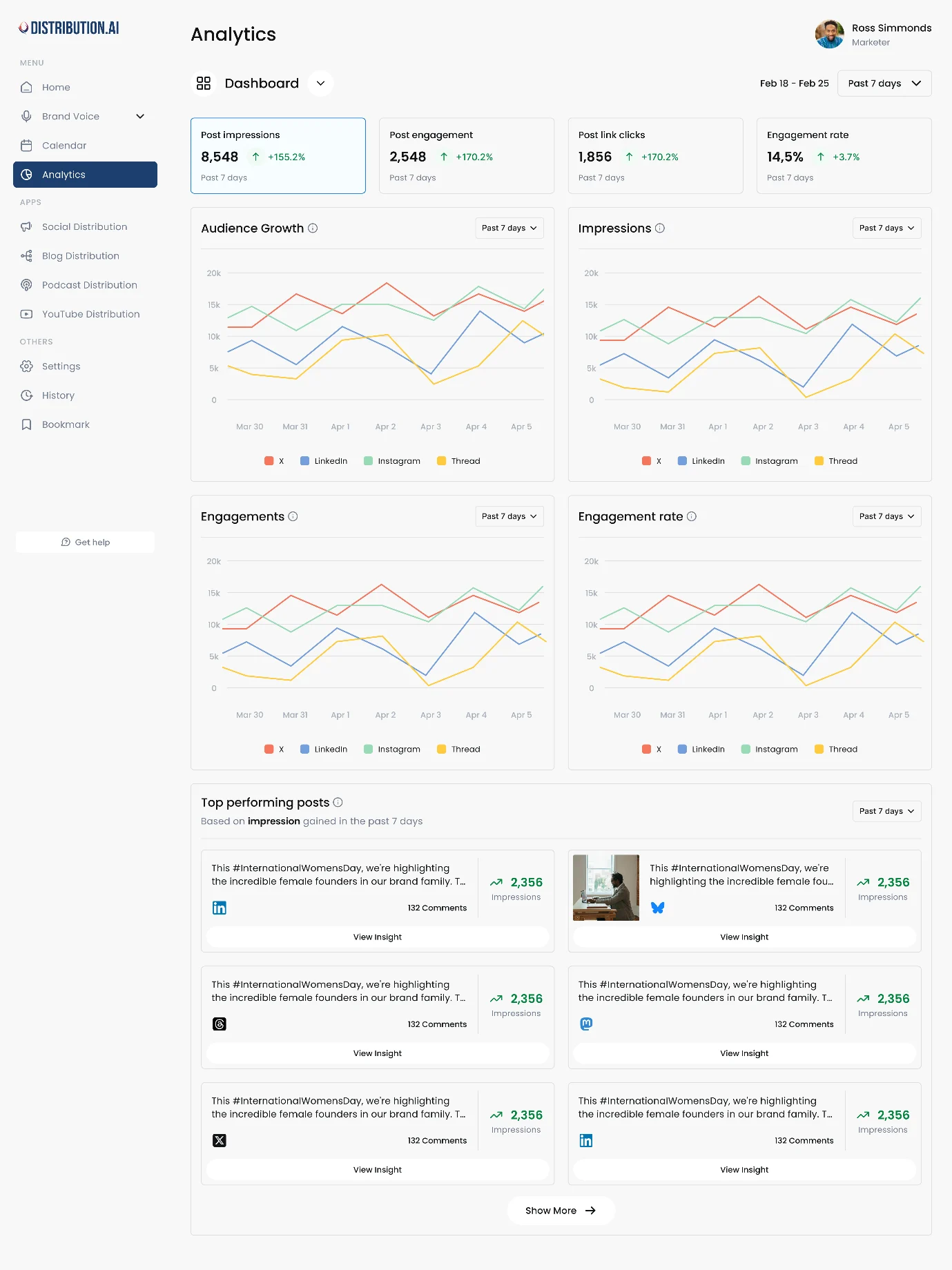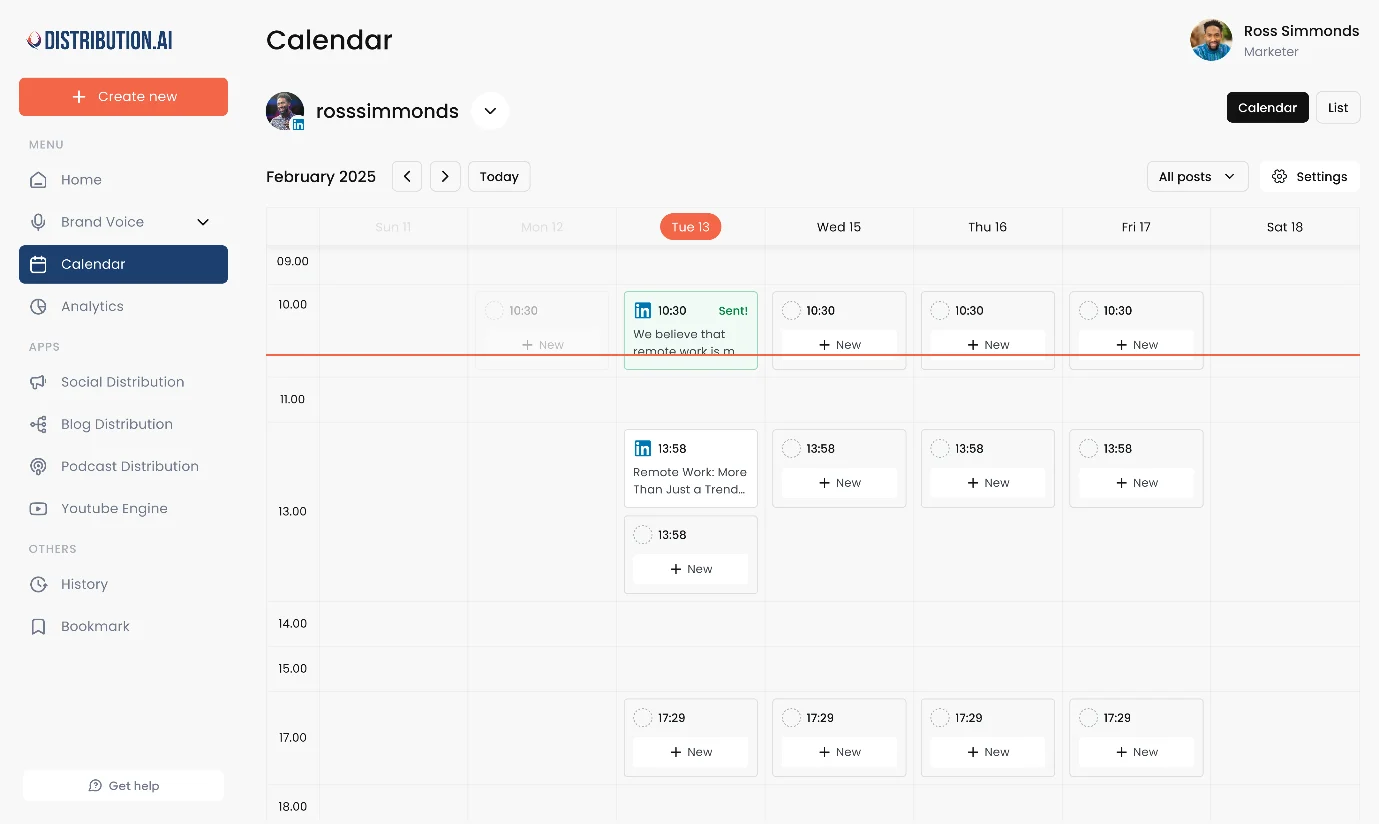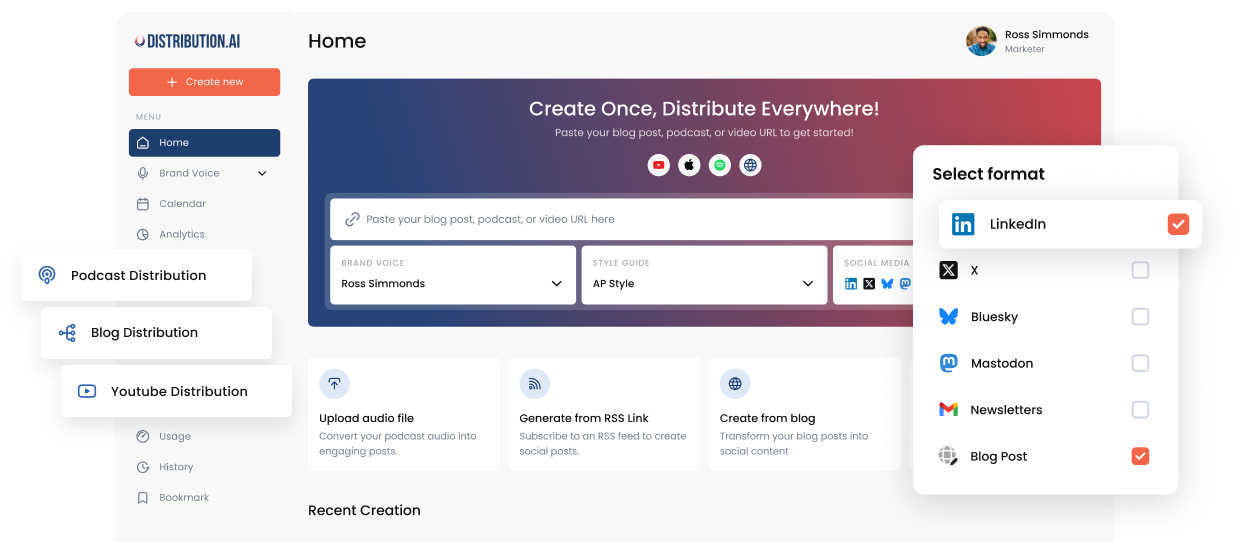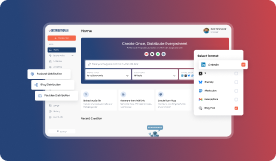25+ Content Marketing Tips Every Marketer Needs to Know
Discover how to create a solid content marketing strategy and get 25+ content marketing tips to boost traffic, establish trust, and scale your business.

Content marketing is more than publishing blogs or posting on social media. It’s more about creating and sharing content that attracts prospects and turns them into loyal customers.
But the truth is, many brands churn out content that no one cares about. Why? Because they skip the basics — a clear strategy, audience understanding, and a sense of purpose.
This guide cuts through the noise. You’ll learn the key steps to building a solid content marketing strategy and discover practical content marketing tips to implement, optimize, and scale it for long-term success.
What is Content Marketing?
Content marketing involves creating and distributing valuable, relevant, and consistent content to attract and retain a clearly defined audience. Done right, it drives traffic and conversions. Unlike traditional advertising, it doesn’t interrupt people with pushy sales messages. Instead, content marketing aims to provide value first and sell later.
A few content marketing examples include Canva’s design tutorials, Airbnb’s travel stories, Distribution AI’s inbound blog, and HubSpot videos or case studies. Even podcasts and newsletters can be part of a successful content marketing strategy.
With a solid content marketing strategy, you can:
- Builds long-term trust with your audience by delivering consistent value
- Drives organic traffic from search engines, helping brands rank
- Supports lead generation by guiding potential customers through the buyer’s journey
- Helps drive social media engagement with shareable content
- Delivers compounding ROI—once published, high-quality content attracts leads and customers for long
How to Create a Content Marketing Strategy?
Here are five steps to create a content marketing strategy:
Define your goals
Before creating content, ask: What business outcome are you aiming for? Is it website traffic, lead generation, or boosting online sales?
For example, HubSpot used blogs to dominate search engines for inbound marketing terms, which fueled their SaaS pipeline. Clear goals ensure every blog, video, or email ties back to measurable growth.
A few SMART goals you could set include:
- Increase brand awareness by 10% in 3 months
- Reduce customer acquisition costs by 6% in 4 months
- Increase the number of downloads by 15% in 5 months
Know your target audience
A clearly defined audience directs your strategy. It guides the type of content you should create for driving results.
Use buyer personas, surveys, or tools like Google Analytics to uncover demographics, behaviors, and pain points.
For instance, Airbnb’s marketing is community-driven. Instead of traditional ads, Airbnb shares user-generated content from guests, travelers, and hosts. These real stories appeal to their audience’s desire for authentic local experiences.
When you know your target audience, you can create relevant content that resonates with your target audience’s needs, provides them with value, or solves their pain points.
Choose the right content type
Not all content types fit every audience. There are various types, including eBooks, blog posts, whitepapers, case studies, video content (such as demos and tutorials), and audio content (like podcasts).
- Match content type with goals and target audience. For example, if brand awareness is the goal, social media platforms work well. If conversions matter more, blogs and case studies are better.
- Factor in your resources. Determine the type of content you can create, what skills you have (writing, editing skills, video skills), how much time your team has, and your content marketing budget.
Run a content audit
Assess the content you already have by performing an audit. This will help you identify content gaps, outdated blog posts, and high-performing assets that can be repurposed.
Distribution AI can help you repurpose content. You can generate social media content using your existing blog posts, podcasts, and videos. Feed your content or links into the platform and generate multiple posts tailored to specific platforms—carousels, infographics, text posts, and images with captions.

Brainstorm ideas and content topics
Look at FAQs, Reddit threads, blogs, podcasts, YouTube, and identify trending keywords to find what the audience is searching for. Use social listening tools to monitor online conversations around trending topics and identify customer pain points. This will help you create targeted content that directly speaks to your target audience.
You can also use social media analytics to identify your top-performing posts and create more similar content.
For instance, tools like Distribution AI help you analyze click-through rates, impressions, engagement, and monitor the top-performing content. You can use these valuable insights for content creation.

Create a content distribution plan
Consistency builds authority. A content calendar helps you plan, align campaigns with business milestones, and avoid last-minute scrambles.
For example, if you’re publishing blogs, create a calendar that mentions the frequency of posts, the number of blog posts going live each month, the topic, keywords, and other details. Similarly, you can also create a calendar for social media marketing that helps schedule posts for publishing across social media channels.

Measure and adapt
A content marketing strategy isn’t “set and forget.” Track marketing messages with metrics like engagement, click-through rates, and conversions.
If blog traffic is high but leads are low, maybe the CTA needs rework. Many brands, like Mailchimp, refine campaigns by constantly A/B testing visuals and headlines. Even for social media campaigns, you can generate multiple post versions and A/B test them to determine which versions perform the best. Tracking metrics and iterating ensures your strategy stays relevant and effective.
25+ Actionable Content Marketing Tips
Here are 25+ content marketing tips that successful marketers swear by:
Strategy & planning tips
1. Use “micro-themes” instead of broad topics
Rather than writing generic blog posts about “content marketing,” pick ultra-focused subtopics like “content marketing for micro-SaaS” or “content marketing onboarding checklist.” These attract niche audiences and help you dominate long-tail content marketing search terms.
2. Map content to customer journey using content clusters
Create 3–5 pillar pages for each major stage (awareness, consideration, decision). Then write cluster posts that interlink and feed into the pillar pages. This builds brand identity, authority, and an internal linking structure that helps you rank higher in search engines.
3. Calendar “idea sprints” quarterly
Once every quarter, block 1–2 days for team brainstorming. Pull inspiration from Reddit pain-point threads, industry forums, or competitor keyword gaps. You can even conduct “Ask Me Anything” (AMA) sessions—Q&A sessions where experts answer audience questions—and review transcripts to uncover content ideas straight from real users.
4. Audit competitors’ gaps
Analyze top-ranking competitors. What keywords are they ignoring? What questions are unanswered in their FAQs? Filling those gaps makes your content marketing examples more relevant than what’s already on page one.
Creation & production tips
5. Co-create with micro-influencers
Collaborate with niche influencers or industry practitioners to co-author a blog or video with you. Their unique perspective adds credibility and increases reach by giving you access to their audience.
6. Use contrast storytelling for technical content
Instead of writing “how we improved CTR by 25%,” frame it with a before/after story: “A blog that used to get zero traffic now drives 300 visits/day.” These stories make content more engaging and stick with the audience.
7. Build a repurpose strategy
Repurpose existing content more than creating new ones. For example, take a long blog post and reframe it as a “10-step checklist,” or reverse it into an infographic, or convert examples into tweets. Instead of reducing sections, change the content’s angle for a fresh perspective.
Learn more about content repurposing in this video: Create Once, Distribute Forever: How Great Creators Spread Ideas and How You Can Too!
Distribution & amplification tips
8. Leverage content seeding groups
Instead of broad sharing, distribute content first to a small, engaged group (e.g., newsletter users, private Discord/Slack group) and ask for feedback, shares, and quotes. This distributes content strategically, helping you reach relevant audiences and build brand visibility, awareness, and credibility.
9. Use platform-native formats to amplify reach
To yield results from your social media marketing efforts, use AI for social media. Create posts tailored to each social platform. For example, if posting on LinkedIn, turn your blog section into LinkedIn carousels or document posts. On Instagram, convert sections into infographics or carousel posts. This repackages content for platform algorithms, boosting reach.

10. Use snippet content for distribution channels
Pull 1–2 striking sentences from your blog post and publish them as quotes, tweets, or social media posts linking back to the full piece. These micro-snippets also make great newsletter hooks that attract attention of your readers.
For example, use a line like “91% of consumers prefer video content” as your subject line or intro, then guide readers to the full article. Snippets keep your content visible across channels without creating something new each time.
Testing, measurement & iteration tips
11. Run “reverse” A/B tests
Instead of guessing what drives performance, take one of your top-performing pieces and cut down sections—fewer visuals, a shorter intro, or less data. Publish both versions and compare the results. By seeing what breaks engagement, you can pinpoint which elements (headlines, structure, or visual content) actually make the content work.
12. Annotate posts with update notes
Add a simple “Last updated on [date] — What’s new: [data, examples, insights]” line at the top of older articles. This signals freshness to readers, builds trust, and tells Google your content is current. It also makes future content audits easier since you can quickly see what’s been revised.
13. Use “surprise metrics” as your KPI
Go beyond likes/shares. Look for unusual signals: Time on page for a specific paragraph, scroll depth on a case study section, number of users who open the content PDF download but don’t click CTA. These micro-signals often predict bigger shifts.
Community & engagement tips
14. Embed community quotes and UGC in your content
Along with user testimonials, search Reddit or industry forums and embed verbatim quotes in your content with attribution. This adds authenticity and gives your content “social proof” from real users. Also, you can use behind-the-scenes videos to humanize your brand and relate to the audience.
15. Create micro challenges tied to content
After a blog post or guide, give readers a small task. For example, a 3-day mini challenge to write one blog post introduction daily using a given template. This boosts engagement, shares, and makes your content more actionable.
16. Use content teasers
Drop teaser snippets of your content in communities like Reddit, Slack, or niche forums. Share the opening 200 words and end with a provocative question that nudges people to read the full piece. However, avoid hard selling, especially in spaces like Reddit, where authenticity is crucial.
17. Build episodic content
Instead of one-off posts, create a series for communicating complex ideas. For example, “Part 1: Defining Personas,” “Part 2: Building Clusters,” and so on. Breaking content into episodes simplifies it and gives readers a reason to return for the next part.
For example, you can do a 5-part carousel series on LinkedIn to build anticipation and drive people back to your profile or page. Or even Instagram or TikTok videos, Part 1, Part 2, and so on. This helps you create a community of loyal audience
18. Schedule content re-runs
Reshare your top content pieces at 3, 6, and 9 months with refreshed visuals or a new intro. For example, a SaaS brand might repost its “Ultimate Guide to Remote Hiring” on LinkedIn with updated stats, then share a short thread on X (Twitter) highlighting 3 takeaways. This keeps evergreen content visible and helps you reach new audiences who missed it the first time.
Bonus tips
19. Repurpose FAQs for social content
Instead of burying FAQs on a webpage, turn each Q&A into a short social media post or a thread on X (Twitter). This transforms support content into bite-sized education.
20. Run time-sensitive playbooks
When big industry news hits, publish a quick “48-hour playbook” (e.g., “How Google’s latest update affects B2B leads”). This urgency drives clicks and even short-term online sales.
21. Embed polls in newsletters
Add a one-question poll in your newsletter tied to the blog’s theme. These interactive content not only boost engagement but also give you data to shape future content.
22. Showcase micro case studies
Not every success story needs 1,000 words. Share quick, three-sentence snapshots: Problem → solution → result. These mini content marketing examples are perfect for readers who skim.
23. Highlight the lessons learned
Share content flops and what you’d do differently. Audiences value honesty, and these stories humanize your marketing messages while teaching others what to avoid.
24. Turn webinars into evergreen guides
Host a live session, then transcribe and polish it into a blog or gated PDF. This is a double win as it brings in real-time engagement, plus you have evergreen content for Google.
25. Tap into hyperlocal stories
Instead of broad trends, share examples tied to a city, region, or niche industry. Such personalized content resonates well and attracts smaller but highly engaged audiences — a tactic useful in B2B content marketing too.
26. Refresh evergreen content
Take a high-performing evergreen blog and add one new insight every quarter (fresh stat, new example, updated image). This ensures your content stays current and relevant.
27. Use personalized content for email marketing
Instead of sending the same newsletter to everyone, segment your list by behavior, interests, or location. For example, if a subscriber often clicks on SEO blogs, send them more SEO-focused guides or webinar invites.
Build A Content Marketing Strategy That Drives Results
Content marketing is about creating content that matters. With a documented plan, a clear audience, and the right mix of formats, you can build trust, drive traffic, and grow revenue.
These content marketing tips give you a framework you can apply right away — from auditing competitors’ gaps to experimenting with episodic content and refreshing evergreen assets. Whether you’re in B2B content marketing, testing new channels, or exploring content marketing services, the goal is to stay consistent, measure results, and adapt.
If you’re ready to level up, get content marketing tools like Distribution AI in your tech stack. It helps you create high-quality content without much brainstorming. It uses your existing content assets and tailors content aligned with your brand voice. You can then schedule and publish these social posts across channels from a single dashboard.
Want to know how Distribution AI can help implement an effective strategy?
Frequently Asked Questions
Promote, repurpose & distribute your content with AI
Start 15-Day Free Trial
